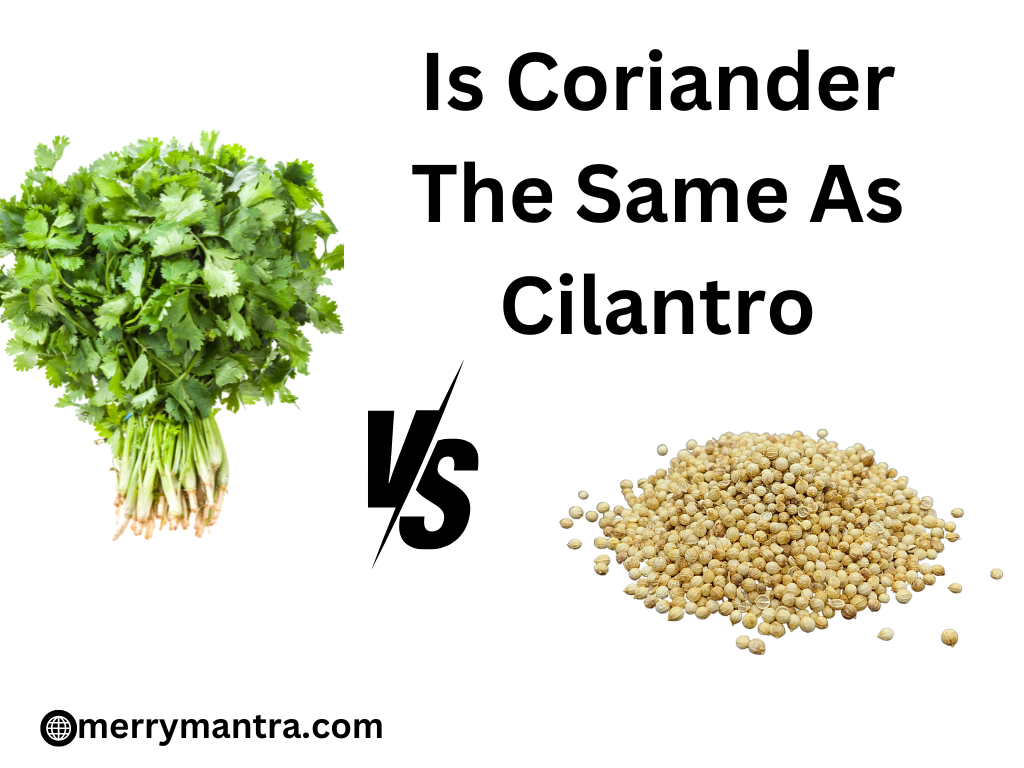The discussions over coriander and cilantro reflect conversations about regional language differences, individual taste experiences, and culinary practices. Both names describe the same herb known as coriander sativum.
The questions arise in every debate such as whether are they the same. Where should these both be used in cooking? If they are not the same then what are the key differences between them?
Therefore, to answer all these questions, in today’s blog, we will explore the similarities and differences between coriander and cilantro to clear your confusion.
What is Coriander?
Coriander belongs to the group of parsley family called Apiaceae. In the USA, coriander is referred to as the dried seeds of the coriander sativum. It is used as a spice in different types of cuisines to offer a spicy, warm, and citrusy taste which is oval in shape with curves along the edges and a slight appearance of round shape.
Coriander may be used as a whole or in powder form according to individual preference and need. It offers a fresh and aromatic essence to cuisines around the world.
What is Cilantro?
The word “Cilantro” comes from a Spanish word. The people in the US call cilantro the leaves of coriander sativum. It is known as Mexican parsley or Chinese parsley because it is derived from a bright green and fresh, leaves and stems, also it comes under the Apiceae family which has a long lace shape with serrated edges. This is mainly used as a garnishing element in stews, soups, etc.
Cilantro adds brightness to a wide range of dishes. It is one of the popular herbs which the company increases its vibrant and distinctive flavor.
Are Coriander and Cilantro the Same?
The honest answer to this question is no. Cilantro and Coriander are not the same. Although they both are derived from the same herb species, certain factors such as uses, flavor, smell, benefits, etc., made a huge importance in their differences.
Let’s go through the key elements which make cilantro and coriander different.
Taste and smell
Coriander seeds contain a warm and aromatic flavor with a little bitter taste. Compared to other spices, the taste is complex and subtle. It adds depth to a variety of dishes with a spicy flavor. The aroma or smell is slightly floral and nutty. It also gives a hint of sweetness and citrusy.
Talking about cilantro leaves enhances the freshness of dishes. However, the taste may be polarizing as some people perceive that due to genetic differences, it has an unpleasant and soapy taste. The fresh scent of these leaves is lively and herbaceous with a blend of citrus aroma.
Health benefits
Coriander seeds help in improving respiratory and cardiovascular health, bone health, enhancing the immune system, and regulating hormonal balance. It has disinfectant possessions which helps in calm skin rashes and mouth sores.
These seeds contain minerals such as magnesium, potassium, manganese, iron, and many more. It also helps in reducing inflammation and blood pressure with a mixture of 8.9% water, antioxidants, phytosterols, and essential oils.
Whereas, cilantro leaves protect against the cell damage and inflammation. They are known as a good source of dietary fibers which manage digestion and blood sugar levels. Although these leaves have fewer minerals as compared to coriander, it is made up of 92.2% of water and vitamins like A, C, E, and K.
Growing and harvesting
Coriander plants yield seeds. After the plant flowers are given time to mature, the seeds grow. The seeds are gathered and used as a spice once they get dry and brown. These seeds can be grown in pots or gardens and are quite simple to grow.
However, cilantro leaves can be grown easily in gardens or pots. It likes cool climates and soil that drains properly. Throughout its growing season, the leaves of this ingredient can be picked many times due to its rapid growth.
Culinary Uses
Coriander seeds are best used in dishes such as stews, sausages, meat rubs, rye bread, spice blends, pickling recipes, and others. Indian chefs use these seeds as an ingredient named “Garam Masala” by roasting them to enhance their taste and aroma. These seeds can also be used in baking for their earthy and citric taste.
On the other hand, cilantro is used as a fresh flavor booster in soups, tea, Indian sauce (chutney), avocado dip, and many more. It is also used in a raw and fresh state for garnishing in Mexican and Southeast cuisines.
Storage
It is often advised to grind coriander seeds because the whole seeds may retain their potency longer than grounded seeds. In order to preserve its flavor and aroma, it should be stored in an airtight container in a dry and cool place.
The cilantro leaves have a short lifespan. It can be stored in the refrigerator or placed the stems in a glass of water.
Conclusion
In the end, cilantro and coriander come from the same plant with different names, parts, and distinct culinary uses. The confusion between these terms arises mainly because of regional terminology.
Understanding its differences is essential for accurate recipe interpretation and effective use in cooking. Ensure that your culinary creations are authentic and flavorful by contributing coriander and cilantro to various dishes.

